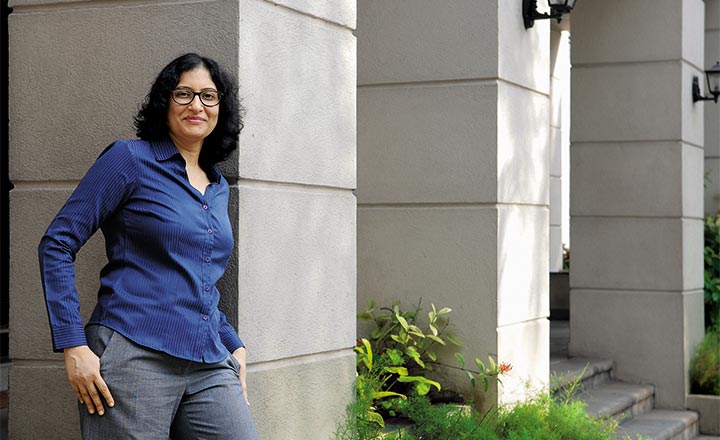It was in 2003 that Roshi Jain began her career with Goldman Sachs as an analyst researching Asian equities out of Singapore. Managing funds was not on the bucket list of Roshi until she started working on the sell-side at Goldman Sachs. A chartered accountant by training, Jain was familiar with the nitty-gritty of the stock market, but the proverbial investment bug only bit her when she was placed at Goldman Sachs from the IIM-A campus in 2003.
Two years later when the opportunity at Franklin Templeton came up in 2005, it was a natural transition to follow her growing inclination towards investing. The switch to the buy-side as an analyst brought her back to her hometown. Born and brought up in Chennai, Jain believes that starting at Goldman Sachs was a good experience as it gave her exposure to different cultures, different geographies and a wide range of companies. While she can’t identify any particular fund manager or investor that inspire her, she says being in the fund management industry brings one in contact with people from diverse backgrounds and that helps to sharpen one’s thought process.
At Franklin Templeton, Jain got to track the infrastructure space, including building materials, capital goods and other smaller sectors such as textiles and transportation. It was tracking infrastructure that honed Jain’s thought process. “You could find several examples of capital misallocation and corporate governance issues in the sector. Those examples helped to sharpen my thinking and focus on companies with good quality management, transparency and capital allocation,” she says.
Money matters
Her first tryst with managing money came in 2008 when she was asked to assist in managing the Asian Equity Fund which had the mandate to identify opportunities in Asia ex-Japan. Given the vastness of this investment universe, Jain’s job was to support R Sukumar, the-then chief investment officer. Together they would identify opportunities in India and the Asean region. “I think at that point of time, we had taken some calls in the banking and consumer space in Indonesia. This was post the global financial crisis and valuations were still low. As growth recovered, some of those bets paid off,” she says.
Jain started managing domestic-oriented funds in 2012 as she became co-manager of the Build India Fund. In 2013, she became co-manager at another domestic fund, the High Growth Companies Fund. Since March 2014, Roshi has been the lead manager of this fund. A diversified multi-cap fund, it focuses on investing in companies that have high growth potential. Jain says that given the research-driven culture at Franklin Templeton, she has a predominantly bottom-up approach when it comes to stock-picking.
“As a house, we focus on long-term sustainable growth stories. We like to invest in stocks with long-term growth drivers. We look for opportunities at a reasonable price,” she says. Financial services and consumption are some of the long-term themes in India that she and the fund house remain bullish on.
 When it comes to assessing valuations, Jain and her team at Franklin Templeton rely on discounted cash flow analysis to find the implied growth that the stock is pricing in. Then begins work to find out if the company is going to grow at a faster rate than what is being factored in the price.
When it comes to assessing valuations, Jain and her team at Franklin Templeton rely on discounted cash flow analysis to find the implied growth that the stock is pricing in. Then begins work to find out if the company is going to grow at a faster rate than what is being factored in the price.
When she got her first shot at managing funds in 2012, there was a lot of pessimism owing to policy paralysis and anemic growth. In FY13, the economy hit a decade-low growth rate of 4.5%. “Mid-caps especially were reflecting that pessimism a lot more. However, we were comfortable with some of the stocks as lot of the growth drivers were in place. Identifying opportunities in mid-caps and playing the rally for the next two-and-a-half years worked really well for both the funds,” she recalls.
 For instance, take the case of Delhi-based Orient Cement. The fund invested in the stock in July 2013 when it was trading at Rs.45. It currently trades at around Rs.134, more than 3x the purchase price. The investment rationale was simple. “There was still enough growth potential in the economy given India’s demographics and under-penetration in consumption as well as infrastructure sector. However, valuations were factoring in muted expectations — low growth and low margins over longer periods of time,” she says.
For instance, take the case of Delhi-based Orient Cement. The fund invested in the stock in July 2013 when it was trading at Rs.45. It currently trades at around Rs.134, more than 3x the purchase price. The investment rationale was simple. “There was still enough growth potential in the economy given India’s demographics and under-penetration in consumption as well as infrastructure sector. However, valuations were factoring in muted expectations — low growth and low margins over longer periods of time,” she says.
Another call that has done well for the fund is Timken India. The fund first bought the stock in April 2014, when the stock was trading at an average price of Rs.198. Today, it trades at Rs.605. “It was not just cement. We were also seeing opportunities in the broad infra/capital goods space. This was a company with a strong product positioning. It was only struggling because the market was weak. Once the market recovered, the company did well,” says Jain.
Apart from industrial stocks, having a higher exposure to consumer discretionary and banking also helped improve the fund’s performance. For instance, Jain first invested in Whirlpool India in March, 2014 at an average price of Rs.257. The stock ticked all the boxes of sustainable high growth potential and attractive valuations. Since then, the stock has surged nearly 4x. Jain feels despite demonetisation, consumer discretionary space remains attractive as the fundamentals remain in place. There is ample room for growth given the under-penetration of product categories and India’s demographic dividend will ensure a steady increase in demand for consumer goods, believes Jain.
In the banking space, a common favourite, HDFC Bank, delivered robust returns for her fund as well. The fund first invested in the stock at an average price of Rs.600 in August 2013. The stock has since more than doubled to Rs.1,377. “It was a high-conviction call on private banks that had the ability to grow without taking on too much asset quality risk,” says Jain.
Stress play
It was not just private sector banks. The fund increased its overall exposure to banking, betting on a recovery in asset quality. “One-and-a-half years back, we went overweight on the banking space as we felt that there was a natural turn in the economy and the worst of the asset quality was priced in.”
 So the High Growth Companies Fund had invested in PSU banks such as SBI and Punjab National Bank in the middle of 2014 and early 2015.These banks, which are facing some asset quality issues, are expected to benefit from the recovery in the economy. Jain admits that the asset quality recovery is taking time, but believes that it is moving in the right direction. “These are banks with a solid deposit franchise where asset quality issues are getting resolved. A large part of the clean-up is closer to getting completed,” she says.
So the High Growth Companies Fund had invested in PSU banks such as SBI and Punjab National Bank in the middle of 2014 and early 2015.These banks, which are facing some asset quality issues, are expected to benefit from the recovery in the economy. Jain admits that the asset quality recovery is taking time, but believes that it is moving in the right direction. “These are banks with a solid deposit franchise where asset quality issues are getting resolved. A large part of the clean-up is closer to getting completed,” she says.
Short-term pressures don’t worry Jain much. Take the case of the telecom sector where the fund has some exposure. Despite the sector’s lackluster performance in recent times, she believes that in the long term, telecom will do well. “If you had met me a month back, I would have told you that I am concerned. But we are seeing consolidation in the telecom space and that is a good sign for the sector. Incrementally, the capex pressure should come off. One must also bear in mind that these are fairly long-term 20-year spectrum assets and the spend for all those assets are upfront.”
The fund first invested in Idea Cellular in December 2014. The stock is trading 29% below the average price the fund bought the stock in 2014, but Jain is not worried. With competitive intensity expected to ease following the likely Idea-Vodafone merger and reported merger of Reliance Communications, Aircel and Sistema, she believes the telecom industry should see better days.
New themes
Going ahead, Jain is sticking to the investment themes that India is known for. “Consumption levels in India will increase. Investment in infrastructure needs to increase. We will find good investment opportunities around these themes.”
In the banking space, new MFIs or small finance banks which have recently entered the listed space have managed to get Jain’s attention. “Some of these companies not only have good business models but also come with good management quality and business processes in place. This business needs good processes as the loan ticket size is small and you need to assess the borrower correctly.” Jain recently invested in Chennai-based Equitas (0.2% of the fund’s net assets), which just launched its small finance bank operations.

The only story that’s unlikely to play out soon is the revival in private capex. “We are not going to see big-ticket capex such as steel plants. There is no rush in India to set up those capacities. There is still significant under-utilisation of capacity. Capex will be more small ticket in nature. We will see bulk of the capex on the public side like we are seeing in railways, dedicated freight corridors, roads and metros,” she points out.
Going the whole hog
One key learning for Jain in her investment journey is the need to be patient as one is investing in real companies and it takes time for business drivers to play out. “You have to be patient. Of course, that patience can only come if you have strong conviction borne out of meticulous due-diligence,” she says. But she believes that you can’t be too hard on yourself as well. According to her, mistakes are inevitable when you are targeting a good strike rate. “Even if we manage to get a 70% strike rate, we should consider it a job well done”, she says.
Her immediate goal though, is to learn to switch off every now and then. Jain says for a fund manager, sometimes it is difficult to tune off and take a break. She is still trying to learn the art of switching off and with time she hopes to get better at it. She believes that more experience brings in a higher conviction level, making money managers less anxious. Given the stellar performance of the High Growth Companies Fund, Jain will master the trait soon and also have more experience by her side.












 Just one email a week
Just one email a week